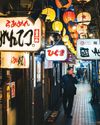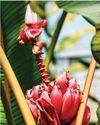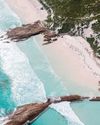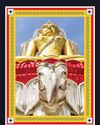
MID-AUGUST, we learned soon after our arrival in Flagstaff, Arizona, is the height of monsoon season. While days were mostly sunny and, at an altitude of 7,000 feet, pleasantly temperate-especially when compared with the summer heat wave in Phoenix, a three-hour drive away-late afternoons and evenings were punctuated by fast-moving storms. One night our charmingly hip hotel, the High Country Motor Lodge (doubles from $144), went abruptly dark in a storm-induced blackout.
My son Asher, a college student, began moaning about the sudden lack of Wi-Fi, and that's when I realized this was a golden opportunity. I dragged him outdoors. The rain had stopped, and a brisk wind was dispersing the clouds that lingered around the San Francisco Peaks, pulling back the curtain on a vast, winking tapestry-pin points of light in an inky black sky.
We had traveled to Flagstaff in part to reacquaint ourselves with the night sky. Home for us is New York City, which the Swiss architect Le Corbusier once described as "a Milky Way brought down to Earth," a place where light pollution renders all but the brightest celestial bodies largely invisible.
Designated in 2001 as the world's first International Dark Sky City, Flagstaff has been working to limit light pollution since at least 1958, when it passed an ordinance remarkable in its foresight-restricting public illumination. It was prompted by scientists at the Lowell Observatory, a privately funded center for astronomical research founded in 1894 in what was then a mountain frontier town. Once Flagstaff received Dark Sky designation, the whole community came to recognize the importance of preserving its views of the stars. More subtle, perhaps, but no less powerful, was the influence of the nearby Diné/Navajo Nation, whose seasons and ceremonies have been organized around the constellations for millennia.
Denne historien er fra April 2024-utgaven av Travel+Leisure US.
Start din 7-dagers gratis prøveperiode på Magzter GOLD for å få tilgang til tusenvis av utvalgte premiumhistorier og 9000+ magasiner og aviser.
Allerede abonnent ? Logg på
Denne historien er fra April 2024-utgaven av Travel+Leisure US.
Start din 7-dagers gratis prøveperiode på Magzter GOLD for å få tilgang til tusenvis av utvalgte premiumhistorier og 9000+ magasiner og aviser.
Allerede abonnent? Logg på

Oodles of Noodles
Slurping through a lantern-lit alley in Sapporo, Japan, where miso ramen was born

The Sweet Spot
Just an hour south of Miami, Nora Walsh finds a candyland of tropical fruits ripe for picking.

Freshly Brewed
In the Cederberg Mountains of South Africa, Kendall Hunter discovers the powerful effects of the humble rooibos plant.

SHORE LEAVE
Raw, wild, and mind-bendingly remote, yet peppered with world-class wineries and restaurants-Australia's South West Edge is a study in contrasts.

Of Land and Sea
Savoring French flavors on a gastronomic trail between Marseille and Dijon.

FAMILY-STYLE
Food writer MATT GOULDING couldn't wait to get back to the hushed omakase restaurants of Tokyo, Kyoto, and Osaka. But would his young kids love the country-and its cuisine as much as he does?

HAPPY MEAL
Many tascas, the no-frills dining spots in Lisbon, have vanished. But others, Austin Bush discovers, are being lovingly reinvented.

A City Abuzz
In underappreciated Trieste, Taras Grescoe finds some of Italy's most storied-and spectacular-coffee shops.

FJORD FOCUS
Norway in December? Crazy-and crazy beautiful. Indulging a family wish, Akash Kapur discovers a world of icy enchantment.

DESTINATION OF THE YEAR Thailand
Full disclosure: I didn't like Bangkok at first. I didn't get it—the chaos, the traffic, the fact that everything was hard to find. But like all good love affairs, my relationship with Thailand—which deepened when I moved from Vietnam 12 years ago to work at Travel + Leisure Southeast Asia, where I'm now editor in chief—took time to blossom.